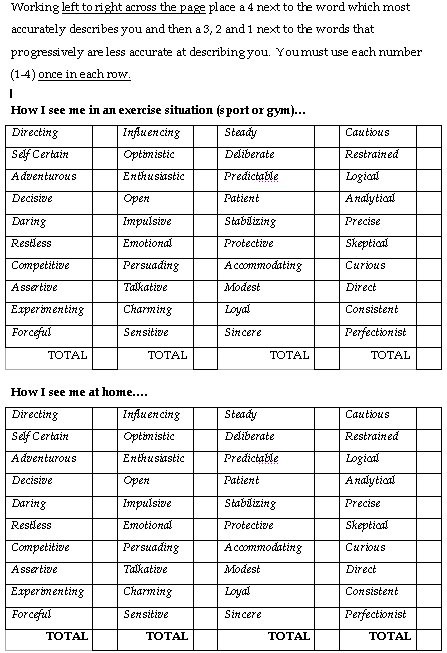How to win personal training clients and influence people. DISC [article] 1
Everyone usually loves me – so what’s
wrong with that guy?
Even the most successful Personal Trainers will have one or two prickly potential clients that they just can’t seem to win over. So why is this? While you can never please everyone, there is a simple tool called DISC that can help you as a trainer improve your communication and rapport building skills. This in turn will help your conversion rate (leads into clients) and help your current clients work towards their goals in the way that they feel most comfortable with.
DISC suggests people are made up of four quite different behavioural styles, which each have certain traits. Individuals will generally have a strongest behavioural style; however it is the combination of all four behaviour types that makes up who we are and how we react.
The four behavioural styles are briefly described below:
D- Dominance:
The D behavioural style centres around control, power and assertiveness. D’s are very direct, goal orientated and driven. They like to be the leader, straight to the point, no messing about. This can sometimes make them seem a little insensitive - which they don’t mean to be. They are just very task focused, and like to do things quickly and efficiently. A good example of a D would be a person in an authoritative position, like Helen Clark.
I - Influence:
The I style is more about social situations and communication. I’s are chatty, they are social creatures who’s main aim in life is to be liked by all around them. They talk a lot, usually very quickly and often about themselves. They tend to have a short attention span and are impulsive, liking spontaneity. They are expressive, like to be the centre of attention and are very people focused. Many entertainers would be high I – like Dame Edna!
S – Steadiness:
The S style is characterised by patience, persistence, and thoughtfulness. They are very steady, calm and loyal. They are a team player, they like consistency and making sure everyone around them is ok. S’s are very caring, people focused individuals, who are usually a bit quieter and like to do things slowly. S’s are resistant to change and can be a little over-sensitive. A person in a very caring role is likely to have quite a high S, perhaps a nurse or a guidance counsellor.
C - Conscientiousness:
The C style is all about structure and organisation. They are cautious, curious, logical and methodical. They like numbers and graphs, are analytical and like to be precise. They ask the ‘why’ questions and often do things slowly as they make sure they are getting it right. C’s can be perfectionists at times, and are very detail and task orientated. Anyone particular about numbers is likely to be quite high C – maybe your accountant!
So why is DISC important to me as a Personal Trainer?
DISC was developed to help us understand behaviour, both in ourselves and others. Once you can identify your own DISC, you will become more aware of your own strengths and weaknesses, and how this affects your interactions with those around you.
DISC also enables you to quickly identify other people’s strongest style, and adjust your own behaviour to suit them. This allows you to tailor your services to provide support and information in the way that will be most appreciated by your client.
As a young trainer starting out, one of my first clients was an extremely high ‘D’. Because I was new and very nervous, it would have been easy for me to let him take charge of the session, as my natural approach to personal training was soft and supportive. Luckily we had just learnt about DISC, and I could adjust my behaviour to be more direct, confident and assertive. Subsequently my new client had much more respect for me, and trained with me for the next five years!
While you need knowledge and skill to train people safely and effectively, the bottom line is that people train with you if they LIKE you. If you can interact with clients in a way that immediately puts them at ease and endears you to them, hey presto – your business is booming!
- Using the chart below, try and identify your own DISC
- Over the next few days, see you who can identify as the strongest ‘D’, ‘I’, ‘S’ and ‘C’ that you know
- The following articles in this series will look more closely at what each behavioural style really wants, and how you can adapt to give it to them:
- Cut to the Chase – The D client in action
- It’s all about me – The I client explained
- We did it as a team – The S client story
- Why why why – Keeping the C client happy
- The final article ‘ Ok now I know their DISC what do I do?’ will help you apply what you’ve learned in a Personal Training setting


You can also complete your DISC profile online
